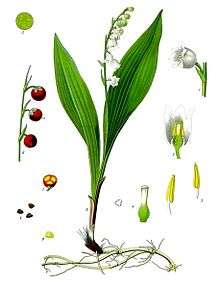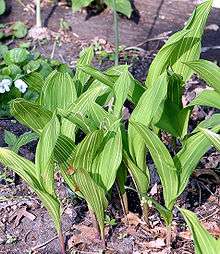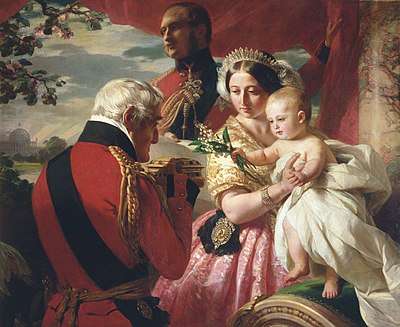Lily of the valley
Lily of the valley, Convallaria majalis (/ˌkɒnvəˈleɪriə məˈdʒeɪlɪs/)[1], sometimes written lily-of-the-valley,[2] is a woodland flowering plant with sweetly scented, pendent, bell-shaped white flowers borne in sprays in spring. It is native throughout the cool temperate Northern Hemisphere in Asia and Europe.
| Lily of the valley | |
|---|---|
| Scientific classification | |
| Kingdom: | Plantae |
| Clade: | Tracheophytes |
| Clade: | Angiosperms |
| Clade: | Monocots |
| Order: | Asparagales |
| Family: | Asparagaceae |
| Subfamily: | Nolinoideae |
| Genus: | Convallaria |
| Species: | C. majalis |
| Binomial name | |
| Convallaria majalis | |

Due to its dense content of cardiac glycosides, it is highly poisonous if consumed by humans or domestic animals.[3][4]
Other names include May bells, Our Lady's tears, and Mary's tears. Its French name, muguet, sometimes appears in the names of perfumes imitating the flower's scent. In pre-modern England, the plant was known as glovewort (as it was a wort used to create a salve for sore hands), or Apollinaris (according to a legend that it was discovered by Apollo).[5]
Description
Convallaria majalis is an herbaceous perennial plant that often forms extensive colonies by spreading underground stems called rhizomes. New upright shoots are formed at the ends of stolons in summer,[6] these upright dormant stems are often called pips.[7] These grow in the spring into new leafy shoots that still remain connected to the other shoots under ground. The stems grow to 15–30 cm (6–12 in) tall, with one or two leaves 10–25 cm (4–10 in) long; flowering stems have two leaves and a raceme of five to fifteen flowers on the stem apex.
The flowers have six white tepals (rarely pink), fused at the base to form a bell-shape, 5–10 mm (0.2–0.4 in) diameter, and sweetly scented; flowering is in late spring, in mild winters in the Northern Hemisphere it is in early March. The fruit is a small orange-red berry 5–7 mm (0.2–0.3 in) diameter that contains a few large whitish to brownish colored seeds that dry to a clear translucent round bead 1–3 mm (0.04–0.12 in) wide. Plants are self-sterile, and colonies consisting of a single clone do not set seed.[8]
Taxonomy
In the APG III system, the genus is placed in the family Asparagaceae, subfamily Nolinoideae (formerly the family Ruscaceae[9]). It was formerly placed in its own family Convallariaceae, and, like many lilioid monocots, before that in the lily family Liliaceae.
There are three varieties that have sometimes been separated out as distinct species or subspecies by some botanists.[10]
- Convallaria majalis var. keiskei – from China and Japan, with red fruit and bowl-shaped flowers (now widely cited as Convallaria keiskei)[8][11]
- C. majalis var. majalis – from Eurasia, with white midribs on the flowers
- C. majalis var. montana – from the United States, with green-tinted midribs on the flowers
Convallaria transcaucasica is recognised as a distinct species by some authorities, while the species formerly called Convallaria japonica is now classified as Ophiopogon japonicus.[11]
Distribution
Convallaria majalis is a native of Europe, where it largely avoids the Mediterranean and Atlantic margins.[12] An eastern variety, C. majalis var. keiskei occurs in Japan and parts of eastern Asia. A limited native population of C. majalis var. montana (synonym C. majuscula) occurs in the Eastern United States.[13] There is, however, some debate as to the native status of the American variety.[14]
Like many perennial flowering plants, C. majalis exhibits dual reproductive modes by producing offspring asexually by vegetative means and by seed, produced via the fusion of gametes.[15]
Ecology
Convallaria majalis is a plant of partial shade, and mesophile type that prefers warm summers. It likes soils that are silty or sandy and acid to moderately alkaline,[16] with preferably a plentiful amount of humus. The Royal Horticultural Society states that slightly alkaline soils are the most favored.[17] It is a Euroasiatic and suboceanic species that lives in mountains up to 1,500 m (4,900 ft) elevation.[18]
Convallaria majalis is used as a food plant by the larvae of some moth and butterfly (Lepidoptera) species including the grey chi. Adults and larvae of the leaf beetle Lilioceris merdigera are also able to tolerate the cardenolides and thus feed on the leaves.[19]
Cultivation

Convallaria majalis is widely grown in gardens for its scented flowers and ground-covering abilities in shady locations. It has gained the Royal Horticultural Society's Award of Garden Merit.[20][21] In favourable conditions it can form large colonies.
Various kinds and cultivars are grown, including those with double flowers, rose-colored flowers, variegated foliage and ones that grow larger than the typical species.[11]
- C. majalis 'Albostriata' has white-striped leaves
- C. majalis 'Green Tapestry', 'Haldon Grange', 'Hardwick Hall', 'Hofheim', 'Marcel', 'Variegata' and 'Vic Pawlowski's Gold' are other variegated cultivars[11]
- C. majalis 'Berlin Giant' and C. majalis 'Géant de Fortin' (syn. 'Fortin's Giant') are larger-growing cultivars[11]
- C. majalis 'Flore Pleno' has double flowers.[11]
- C. majalis 'Rosea' sometimes found under the name C. majalis var. rosea, has pink flowers.[11]
Traditionally Convallaria majalis has been grown in pots and winter forced to provide flowers during the winter months, both for as potted plants and as cut flowers.[22]
Chemistry
Roughly 38 different cardiac glycosides (cardenolides) – which are highly toxic if consumed by humans or domestic animals – occur in the plant, including:[3][4][23]
|
The odor of lily of the valley, specifically the ligand bourgeonal, was thought to attract mammalian sperm.[24] The 2003 discovery of this phenomenon prompted research into odor reception,[25] but a 2012 study demonstrated instead that at high concentrations, bourgeonal imitated the role of progesterone in stimulating sperm to swim (chemotaxis), a process unrelated to odor reception.[26]
Uses
Perfume
In 1956, the French firm Dior produced a fragrance simulating lily of the valley, which was Christian Dior's favorite flower. Diorissimo was designed by Edmond Roudnitska.[28] Although it has since been reformulated, it is considered a classic.[28][29]
Other perfumes imitating or based on the flower include Henri Robert's Muguet de Bois (1936),[30] Penhaligon's Lily of the Valley (1976),[28] and Olivia Giacobetti's En Passant (2000).[28]
Weddings and other celebrations

Lily of the valley has been used in weddings[31] and can be very expensive.[32] Lily of the valley was featured in the bridal bouquet at the wedding of Prince William and Catherine Middleton.[32][33] Lily of the valley was also the flower chosen by Princess Grace of Monaco to be featured in her bridal bouquet.
At the beginning of the 20th century, it became tradition in France to sell lily of the valley on international labour day, 1 May (also called La Fête du Muguet (Lily of the Valley Day) by labour organisations and private persons without paying sales tax (on that day only) as a symbol of spring.[34]
Lily of the valley is worn in Helston (Cornwall, UK) on Flora Day (8 May each year, see Furry Dance) representing the coming of "the May-o" and the summer. There is also a song sung in pubs around Cornwall (and on Flora Day in Cadwith, near Helston) called "Lily of the Valley"; the song, strangely, came from the Jubilee Singers from Fisk University in Nashville, Tennessee.[35]
Folk medicine
The plant has been used in folk medicine for centuries.[36] There is no scientific evidence that lily of the valley has any effective medicinal uses for treating human diseases.[3][23]
Cultural symbolism
The lily of the valley was the national flower of Yugoslavia,[37] and it also became the national flower of Finland in 1967.[38]
In the "language of flowers", the lily of the valley signifies the return of happiness.[31]
Myths
The name "lily of the valley", like its correspondences in some other European languages, is apparently a reference to the phrase "lily of the valleys" (sometimes also translated as "lily of the valley") in Song of Songs 2:1 (שׁוֹשַׁנַּת הָעֲמָקִים). European herbalists' use of the phrase to refer to a specific plant species seems to have appeared relatively late in the 16th[39] or 15th century.[40] The New Latin term convallaria (coined by Carl Linnaeus) and, for example, Swedish name liljekonvalj derives from the corresponding phrase lilium convallium in the Vulgate.
Gallery
 Convallaria close-up
Convallaria close-up Moldovan stamp
Moldovan stamp 1 May, by Franz Xaver Winterhalter
1 May, by Franz Xaver Winterhalter Lunner (Norway) municipal coat of arms
Lunner (Norway) municipal coat of arms
References
- Sunset Western Garden Book, 1995:606–607
- "BSBI List 2007". Botanical Society of Britain and Ireland. Archived from the original (xls) on 2014-10-23. Retrieved 2014-10-17.
- "Lily of the valley: Guide to Poisonous Plants". Colorado State University. 2019. Retrieved 29 July 2020.
- "Lily of the valley: Safe and Poisonous Garden Plants". University of California. 2020. Retrieved 29 July 2020.
- Cockayne, Thomas Oswald (1864). Leechdoms, Wortcunning, and Starcraft of Early England: Being a Collection of Documents, for the Most Part Never Before Printed, Illustrating the History of Science in this Country Before the Norman Conquest. London: Longman, Green, Longman, Roberts, and Green. pp. 121.
glovewort.
- Flora of China: Convallaria majalis
- Mills, Linn; Post, Dick (2005). Nevada gardener's guide. Nashville, Tenn.: Cool Springs Press. p. 137. ISBN 978-1-59186-116-4.
- Ohara, Masashi; Araki, Kiwakoi; Yamada, Etsukoi; Kawano, Shoichi, Life-history monographs of Japanese plants, 6: Convallaria keiskei Miq. (Convallariaceae), Plant Species Biology, Vol 21, No 2, August 2006, pp. 119–126(8), Blackwell Publishing
- Chase, M.W.; Reveal, J.L. & Fay, M.F. (2009), "A subfamilial classification for the expanded asparagalean families Amaryllidaceae, Asparagaceae and Xanthorrhoeaceae", Botanical Journal of the Linnean Society, 161 (2): 132–136, doi:10.1111/j.1095-8339.2009.00999.x
- "Convallaria in Flora of North America @". Efloras.org. Retrieved 2012-04-30.
- RHS Plant Finder 2009–2010. Dorling Kindersley. 2009. pp. 195, 196. ISBN 978-1-4053-4176-9.
- "Liljekonvalj Blomningstid" (in Swedish). Retrieved 16 May 2018.
- Flora of North America : Convallaria majalis
- Gleason, Henry A. and Cronquist, Arthur, (1991), Manual of Vascular Plants of Northeastern United States and Adjacent Canada, New York Botanical Garden, Bronx, New York, pp. 839–840
- Vandepitte, Katrien; De Meyer, Tim; Jacquemyn, Hans (February 2013). "The impact of extensive clonal growth on fine-scale mating patterns: a full paternity analysis of a lily-of-the-valley population (Convallaria majalis)". Annals of Botany. 111 (4): 623–628. doi:10.1093/aob/mct024. PMC 3605957. PMID 23439847.
- "Lily of the Valley Planting Guide". easytogrowbulbs.com. Retrieved 12 May 2015.
- RHS Encyclopaedia of Perennials
- Rameau, J. C.; et al. (1989). Flore Forestière Française. Institut pour le développement Forestier. p. 1023. ISBN 978-2-904740-16-9.
- Whitman, Ann. "Controlling Lily Leaf Beetles". Gardner's Supply Company. Retrieved 12 May 2015.
- "Convallaria majalis". RHS. Retrieved 2020-04-17.
- "AGM Plants - Ornamental" (PDF). Royal Horticultural Society. July 2017. p. 22. Retrieved 24 January 2018.
- Journal of horticulture and practical gardening. 1872. p. 378. Retrieved 28 September 2010.
- Roberts, Darren M.; Gallapatthy, Gamini; Dunuwille, Asunga; Chan, Betty S. (2016). "Pharmacological treatment of cardiac glycoside poisoning". British Journal of Clinical Pharmacology. 81 (3): 488–495. doi:10.1111/bcp.12814. ISSN 0306-5251. PMC 4767196. PMID 26505271.
- Marc Spehr; Günter Gisselmann; Alexandra Poplawski; Jeffrey A. Riffell; Christian H. Wetzel; Richard K. Zimmer; Hanns Hatt (2003). "Identification of a Testicular Odorant Receptor Mediating Human Sperm Chemotaxis". Science. 299 (5615): 2054–8. Bibcode:2003Sci...299.2054S. doi:10.1126/science.1080376. PMID 12663925. Retrieved 24 June 2012.
- See also: Babcock, Donner F. (28 March 2003). "Development. Smelling the Roses?" (PDF). Science. 299 (5615): 1993–1994. doi:10.1126/science.1083059. PMID 12663902. Archived from the original (PDF) on 4 May 2006. Retrieved 12 June 2014..
- For example ScienceDaily 2007
- Christoph Brenker; Normann Goodwin; Ingo Weyand; Nachiket D Kashikar; Masahiro Naruse; Miriam Krähling; Astrid Müller; U Benjamin Kaupp; Timo Strünker (2012). "The CatSper channel: a polymodal chemosensor in human sperm". The EMBO Journal. 31 (7): 1654–1665. doi:10.1038/emboj.2012.30. PMC 3321208. PMID 22354039. See also ScienceMag article
- "Poisonous plants: Lily of the valley". Ontario Poison Centre, The Hospital for Sick Children. 2015.
- "Lily of the Valley Perfumes". Vogue slideshow.
- Patty. "Best Lily of the Valley Perfume – Muguet Guide". Perfume Posse, April 8, 2013.
- Morris, Edwin T. (1984). Fragrance : A story of perfume from Cleopatra to Chanel. New York: Scribners. ISBN 978-0684181950.
- "Wedding Traditions & Trivia". Archived from the original on 2012-07-15. Retrieved 2012-07-23.
- Lily of the Valley Stars in Royal Bridal Bouquet
- Balcony kisses seal royal wedding
- "Lily of the Valley – May Day in France". wordpress.com. 26 April 2010. Retrieved 24 June 2015.
- Coleman and Burley, Hilary and Sally (2015). Shout Kernow. London: Francis Boutle Publishers. pp. 53–55. ISBN 978-1903427972.
- Weiss, RF (1988). Herbal Medicine. Ab Arcanum. pp. 146–147. ISBN 978-0906584194.
- "Lily of the valley". flowers.org.uk. Retrieved 24 June 2015.
- "Lily of the Valley – Finland's National Flower". wordpress.com. 28 May 2013. Retrieved 24 June 2015.
- https://www.etymonline.com/search?q=lily+of+the+valley
- Keil, Gundolf. „Es hat vnser libe fraw gesprochen in dem puch der libe: ‚Ich pin ein plvm des tals vnd auch des grvnen waldes‘“: Die Einführung der Convallarin-Glykoside als Hinweis auf mährisch-schlesische Provenienz. In: Iva Kratochvilová, Lenka Vaňková (Hrsg.): Germanistik im Spiegel der Generationen. Festschrift Zdeněk Masařík. Opava/ Ostrava 2004, S. 72–132.
External links
| Wikiquote has quotations related to: Lily of the valley |
| Wikimedia Commons has media related to: |
- Invasive Plant Atlas – US Distribution Map
- Convallaria majalis fact sheet – NC Cooperative Extension